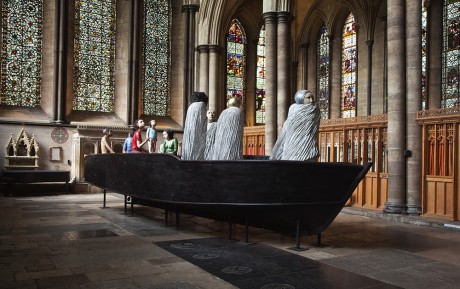We were out for a walk last week when we discovered this pool. It sits in front of the Scottish Parliament and, if you are careful and concentrate, it is a place where you can walk on water. Art to make you wonder.
And this morning, I find that this image resounds with yesterday’s reading. There are some weeks when the readings linger and I have a difficult time moving into a new week. Yesterday, it was John 14:1-14 I am the way, the truth, and the life. Twice, I read those words aloud during worship and both times I stumbled a little. I wasn’t quite sure how to pause properly for the different images. I wanted to emphasize way because it fit in with the sermon, but I also hoped that the very familiar passage wouldn’t slide past too quickly. I think it just sounded a little like I’d lost my place. Maybe my lingering with the words today has something to do with yesterday’s stumbling.
There is something in that strong, concrete image. Something that pulls me in. I am the way. The very earliest church took this image as their name. Christ’s followers were more commonly called “followers of the way” than “Christians” in those beginning days.
I am the way.
It is an evocative and ambiguous name, isn’t it? It gives us a sense of movement and casts Christ as the method rather than the destination. We are on a pilgrimage and Christ is how we walk. Christ is manner and method. Worship becomes practise. Christ becomes visible as we live. I think it’s like this: a way needs walkers. Otherwise it is an arbitrary line through the landscape. You can see a way when people travel it. With walkers, a way becomes a visible connection from A to B as well as a place in itself. We are on the way as we travel from where we were to where we are going.
Pilgrimage is a strong image for me and perhaps more strongly in this season for my family. In a matter of weeks, the Spouse will be submitting his PhD so our next step is beginning to loom. There will be job hunting and applications and prayers for open doors, open hearts. Open ears, too, so that we might hear the callings that come. And strong boots and hearts to keep us on the way together. Of course, our life doesn’t feel settled right now and I’ve been wondering if it ever will and if, perhaps, the lack of being settled is a good thing. Then I worry that it isn’t and that the kids need rootedness to flourish. I wonder and I worry and then I walk around the neighbourhood with Plum snoozing on my back and I think about the Way.
Sometimes we need strong images to give us courage.
- Ana Maria Pacheco, The Longest Journey, 1994. Polychromed wood, 320x335x1000cm
Photo: Colin M. Harvey, reproduced courtesy of Pratt Contemporary, UK
Shows sculpture installed in the North Transept of Salisbury Cathedral during the Salisbury International Arts Festival 2012
Two years ago, a marvellous sculpture made its home in Salisbury Cathedral for the summer. It is called The Longest Journey – a 32-foot wooden boat, carrying 10 passengers. Imagine coming across a giant boat in your church. The artist, Ana Maria Pacheco, often explores the themes of exile and hope, and in this work, I see a strong depiction of the ambiguous image of the way. Pacheco is a Brazilian artist who is best known for her multi-person sculpture installations. The figures in the boat are compelling. Half of these are dressed in contemporary clothing, half are wearing robes, white and enveloping. Some look down out of the boat as if into the waves. Others point their faces to the sky. They are eerie, lovely, hopeful, mourning, human figures. There is no one response to these faces nor to their unclear journeying. But you look and you wonder. What is the boat? Who are the people? Clothes or robes? Who is going home? Who is travelling elsewhere? These people are in motion and at rest, contained yet precarious, too. Their way is unknown.
You can look at more images of The Longest Journey on the Artway website. Artway is a website with resources, images, and articles, linking art and faith. You can also find images at Pratt Contemporary Art, the studio which represents Ana Maria Pacheco. You can see good, clear images of the faces as well as get a sense of the figures’ placement within the boat. But it is difficult to take photographs of sculpture. You need to feel your own presence next to these large-scale figures. It asks to be experienced in three dimensions. To get a full sense of such work, you need to walk around it. Photographing sculpture is like describing the Way. You can convey a sense, a glimpse perhaps. To understand, you need to get your boots on and walk.



